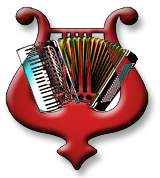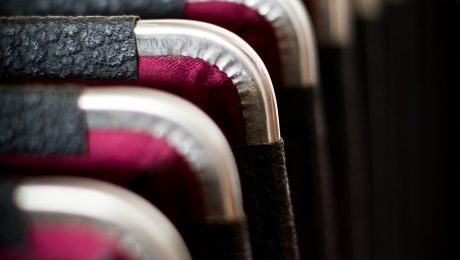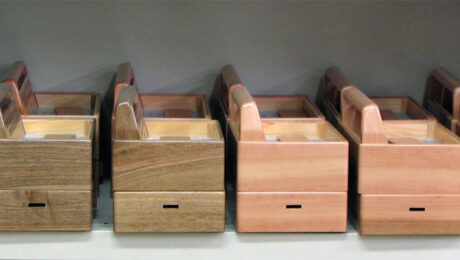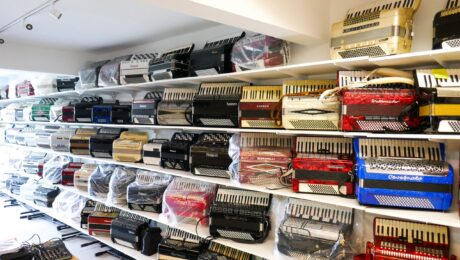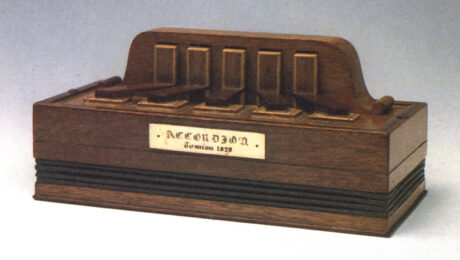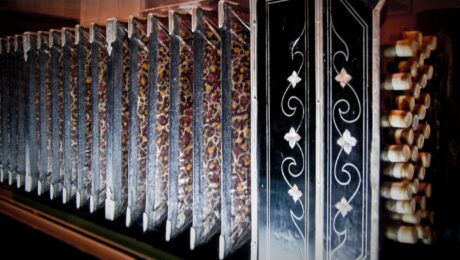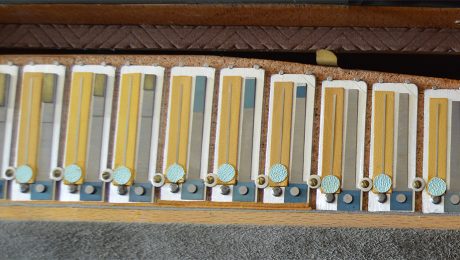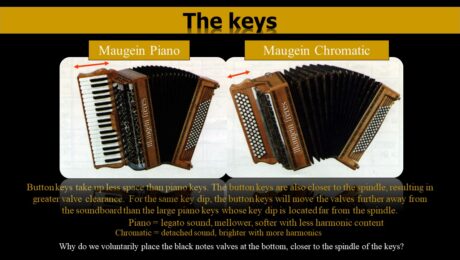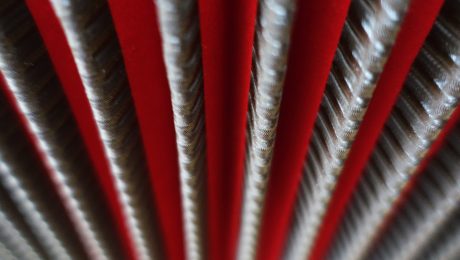Castelfidardo
Now, let me introduce you to the Accordion’s World Capital.

This is Castelfidardo, the world capital of the accordion. I had the opportunity to visit it twice. Still around today, we can count thirty accordion factories.
It’s a great place to spend vacation because it’s near the Adriatic Sea.
I recommend Sirolo just by the sea and Mount Conero with its Abbey transformed into a bed and breakfast.
To learn more about Castelfidardo, go to my Castelfidardo page at https://en.mariobruneau.com/castelfidardo
Watch a video created from photos taken during my visits to Castelfidardo: https://www.youtube.com/watch?v=fHBhWXcjNRM
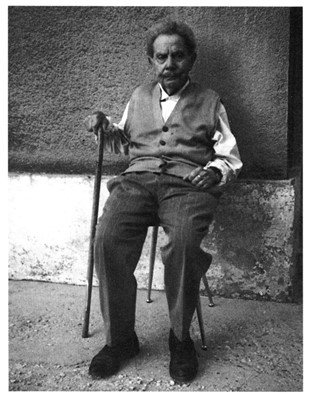
In 1897 PAOLO SOPRANI played an important role in the evolution of the accordion. It is thanks to the ingenuity of several craftsmen like Mattia Beraldi and Raimondo Piatanesi who in 1897, filed a patent for chromatic accordion and the ingenious system of rollers for the left hand.
So, the year 1900 represents an important turning point in the accordion. Indeed, it goes from diatonic instrument to chromatic, a clear evolution.
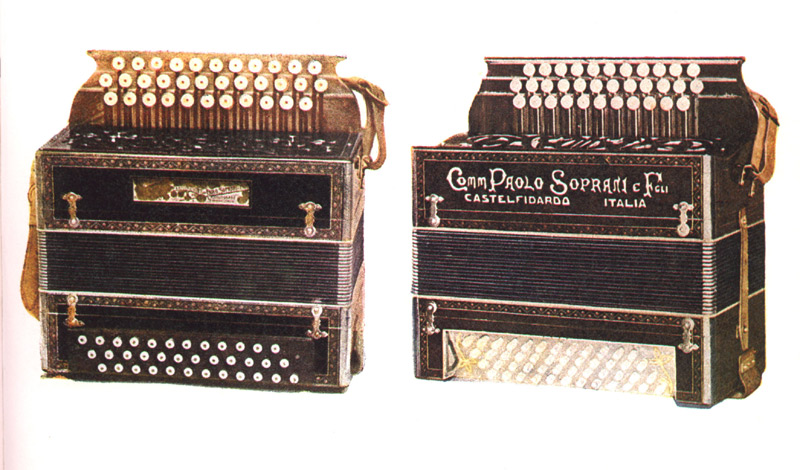
Gionanni Gagliardi is a great musician and a great craftsman for the accordion factory.
He moved to Paris in 1907 and achieved great success in Montmartre and the accordion became the instrument all Montmartre talks about, the regulars of the Bateau-Lavoir, Lapin-Agile or Moulin-de-la-Galette. Between 1900 and 1924, Paris was the place to be!
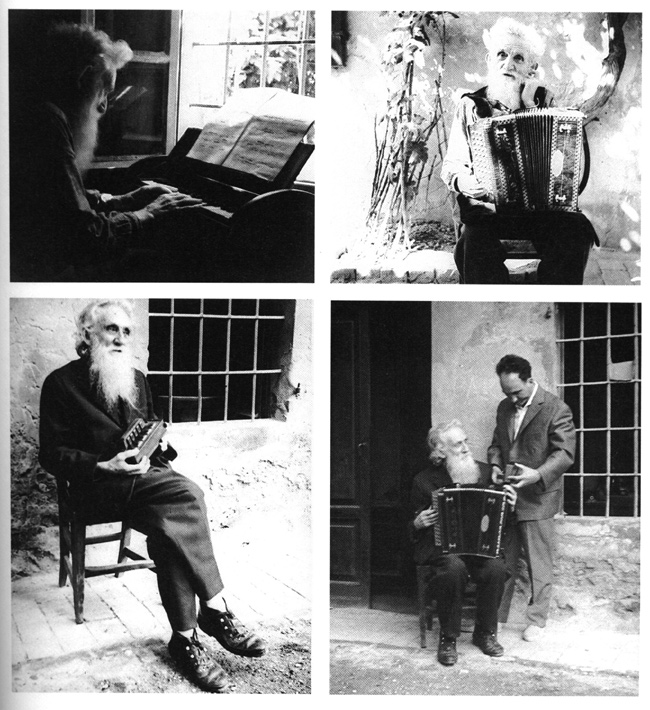
Minor causes, major effects
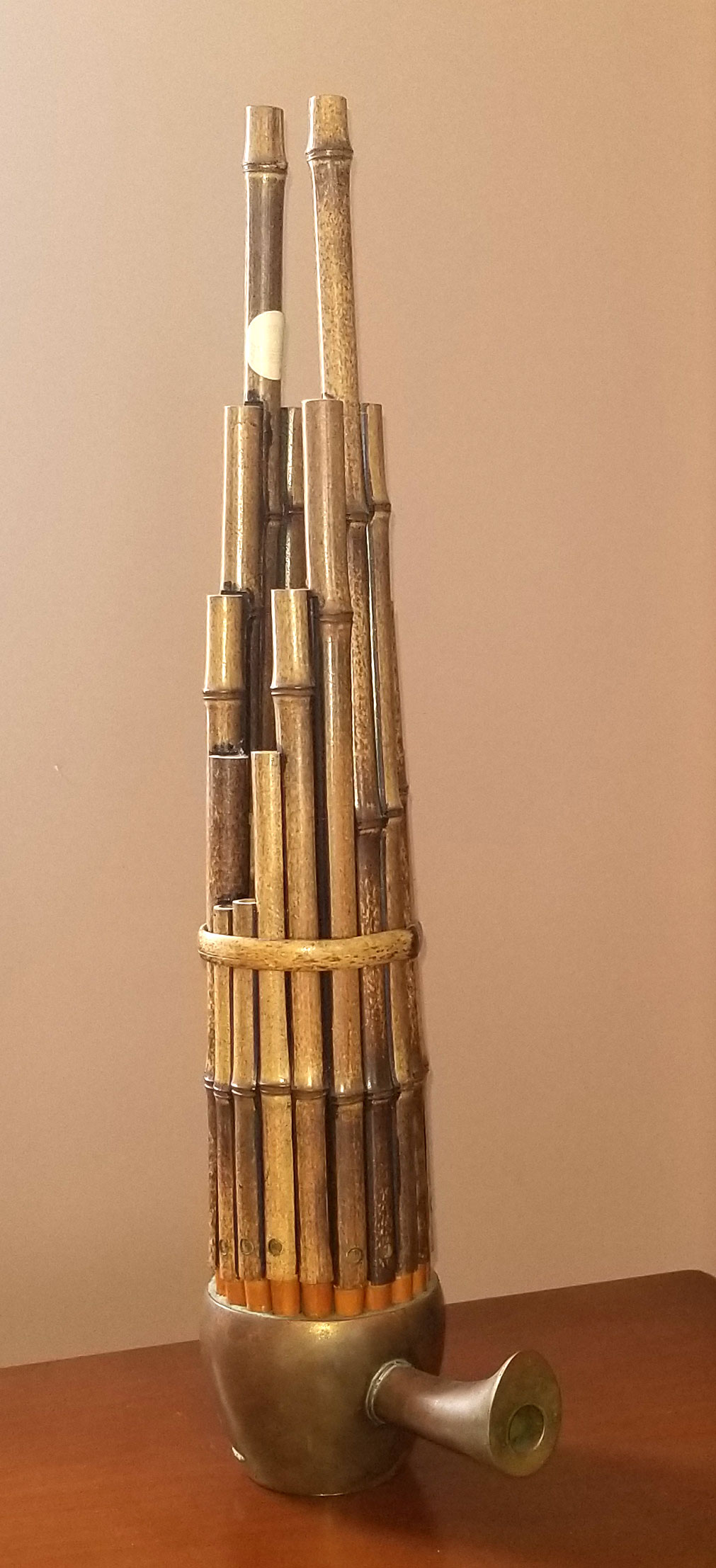 Trois mille ans avant notre ère, au cours de l’élaboration d’un mécanisme pour fabriquer une sorte d’orgue à bouche nommé sheng ou cheng, les Chinois ont inventé l’anche libre. (more…)
Trois mille ans avant notre ère, au cours de l’élaboration d’un mécanisme pour fabriquer une sorte d’orgue à bouche nommé sheng ou cheng, les Chinois ont inventé l’anche libre. (more…)
7 Crucial Tips You Should Follow When Flying With Your Accordion
7 Crucial Tips You Should Follow When Flying With Your Accordion
accordions, Care & Maintenance
What’s even scarier than snakes on plane? Instruments on plane! After spells of hard work, you may be packing up to head out on a much-needed travel break for some quality time. If you are planning to bring your accordion along to add to the magic, here are seven important tips to keep in mind while traveling:
1. Know the Airline Policies
In 2013, the Congress ruled any musical instrument that fits the plane’s overhead compartment can be brought on the plane as a carry-on item, which is excellent news for musicians who small-sized instruments, such as violins, ukulele and travel-sized accordions and guitars. For larger instruments, like basses and cellos, depending on their size and the airline, you might have to pay an extra fee or even buy an additional ticket for your instrument friend to be able to travel with you.
Even if you are not traveling by means other than a plane, i.e. a boat, train, or even your dad’s RV, you should still have a good idea about the policies regarding baggage. The more you know, the better you will be prepared to build your case should anyone have a problem with your instrument.
2. Prepare Your Instrument for Flight
Remember that storage for carry-on baggage follows the ‘first come, first served’ basis, so it is best to prepare for instrument for gate check. This way, you will be covered even if there is a shortage of room on board. Keep the following pointers in mind:
Make sure your instrument is stored in a hard case, not a soft one, and especially not a polyfoam one. Although polyfoam cases are great for providing adequate protection and portability for day-to-day handling, they still cannot make up for the abuse faced by luggage during and after a flight.
Choose a firm wooden case, even though you can never really go wrong with a case especially designed for travelling with TSA latches. SKB and Gator are two great companies that make flight-safe cases, but they can be a little expensive as compared to the other standard ones.
Do not pack any tools and accessories in the same case as the accordion. Examples may include tuners, cleaning supplies, shoulder straps, extra buttons and keys, multi-tools, cutters, string winders and hex wrenches.
ALSO READ:
Top 10 Important Accordion Tips for Beginners
Although these items may seem pretty commonplace and harmless for musicians, they may be foreign and unfamiliar to airport security staff. You need to avoid giving anyone a reason to carry out a search on you because not only does it waste time but can also lead to accidental dropping and rough handling of the delicate accordion.
When placing the accordion in its protective casing, be sure that it fits perfectly, without leaving any evident wiggle room. If you notice an unoccupied spots, stuff them with towels, T-shirts or rags, but not too much that it ends up adding extra pressure on the instrument enough to potentially harm it, but sufficient for preventing the accordion from moving freely around.
3. Put an ID Tag on the Accordion Case
A musician’s worst nightmare is to lose his prized possession just before a performance or a big event. Avoid that by sticking a big ID tag, written in comprehensible writing, on your accordion’s case, front and back. This should include your name, contact information, address and emergency contact info.
4. Take Into Consideration the Elements
Whether you are driving yourself to the airport or taking a cab, make sure to not put your accordion in the vehicle’s trunk for long periods, especially during the day. Leaving an accordion in a scorching day in the back of the car’s trunk will only ruin its finish, warp the wood, and may cause serious damage to the keys and bellows. Consider the climate. If the weather of the destination you are travelling to is dry, consider bringing along a humidifier, which will help maintain the accordion’s moisture level in a healthy way.
5. Arrive Early
Whenever you are travelling, it is always a good idea to arrive early, especially if you are carrying an instrument. Having plenty of time before your flight takes off will allow you to tackle any hurdles that may spring up at the last minute, for example a particularly exasperated cab driver. Having some time on hand will help you maneuver your way to the ideal spot on the plane or bus, and that could be the difference between keeping your accordion in the overhead compartment or being forced to checking it in (and risk having it handled roughly).
ALSO READ:
The Best Songs You Can Play On Your Accordion
6. Boarding Tips
Now that you have packed your accordion safely and securely, keep in mind the following tips for safe and successful boarding:
Keep your cool with airport security staff and be polite when dealing with them. Arguing or behaving rudely will only risk your chances of successfully carrying your accordion on board. Treat them with respect and you will be more likely to get accommodated better.
Always carry a copy of the official rules and policies regarding instruments as some flight attendants and gate agents might be unaware and can therefore cause unnecessary hassle.
You can be a little sneaky and pay more for priority to ensure you find a spot for your accordion before the overhead compartment fills up.
Some airlines keep an additional storage room or closet, which can vary according to the size of the aircraft. Make sure you inquire about this from a flight attendant to safely stow your accordion throughout the flight.
7. Always Be Prepared
You always need to be prepared when travelling with your accordion. Keep extra cash on hand, in case you need to buy an extra ticket to place the instrument. Be extra careful and make sure all zippers are thoroughly zipped, clasps tightly closed and your name and addressed clearly pasted on the outside and inside of the case. Also, be prepared to repack your instrument efficiently in case it is opened up and searched.
- Published in accordion, Care and maintenance
Interesting Facts about Accordions
The Accordion is one of the most unique yet underrated musical instruments today. While many people believe its basic form was invented in Vienna in 1829, other sources credit the Chinese Cheng for what the accordion is today and mostly because they share the same sound source that is, the free reed.
What is an Accordion?
An accordion is a box-shaped musical instrument that comes from a bellow-driven, reedless aerophone family. It has keys like a piano, but is held by the accordionist when playing. The instrument produces sound when you press the keys or buttons and at the same time, compress or expand the bellows. Buttons or keys are played on the right and left side. Today, the accordion is popular in various music styles worldwide.
How to Play an Accordion?
Playing an accordion requires nimble fingers yet a sharp and calm mind. The instrumental has quite a complicated structure with various important internal features and three main external parts which include:
- The treble keyboard which is located on the right hand side of the accordion when you are holding it. It is similar to that of a piano’s keyboard, and comes with black and white keys which vary depending on the size of the instrument. The bigger it is, the more keys it will have, thus allowing you to play more tunes.
- The bass keyboard is on the left side of the accordion when you hold it in the proper position. It comprises of a variety of buttons arranged in accordance with the families of notes. Each button plays a specific bass chord or note when pressed.
- The bellows are situated in the middle or “heart” of the instrument. The bellows are particularly important as they help in air circulation through the reeds inside the instrument. It is imperative to ensure that bellows stay airtight and not get weakened or over-stressed. Your accordion will usually have one or two straps for holding the bellows close. Even when the instrument is not in use, make sure the straps are fastened
Additional important parts include:
- The air button is typically found near the bass buttons. When you push it, a valve opens which facilities the operation of the bellows without allowing air to flow through the reeds. This is important, especially if you don’t want to produce any sound when opening or closing the bellows.
- Couplers are additional large buttons or keys found on most accordions just above the bass board and keyboard. They change the selection of reeds being played and thus produce different modes of sound.
- Reeds are an internal part of the accordion and are fixed at one end and free at the other to allow vibration. The sounds produced by the accordion are a result of air being forced through the reeds when you push the bellows, causing them to vibrate. Different chords and notes are produced when air flows through various combinations of reeds when you press different buttons and keys.
- Every accordion comes with two protective shoulder straps that circle around the shoulders to help the player in holding the instrument as close to his body as possible. For added support and correct position, you can also get a third strap that links the two shoulder straps at the back. If you have a larger accordion, it is best if you use a middle strap to distribute the instrument’s weight evenly.
Interesting Facts about Accordions
- The accordion is widely used in folk music, pop music, jazz, zydeco, classical, and dance-pop.
- An accordion is a complex structure of different configurations
- The pitch of a unisonoric accordion remains the same, regardless of the direction in which you move the bellows.
- You can play the bisonoric accordion at different pitches. You have to manipulate the direction of the bellows to produce the desired sound.
- Manual accordions designed for right-handed players can feature a keyboard similar to a piano, or a diatonic or chromatic board.
- Accordion music can be found in Brazil, Mexico, Colombia, Canada, the United States, South America, Europe, and various other places.
- The bellows are a segment of cloth, leather, metal and cardboard positioned between the two manuals (buttons and keyboards). The bellows are contracted and expanded by the player, which then creates pressure and vacuum and pushes the air through the chambers of the reeds to produce sound.
- The accordion can withstand its harsh surroundings and has a longer lifespan that most instruments.
- The first men ever to play the accordion were Abe Goldman, Joe Biviano and Gene von Halberg at the famous Carnegie Hall in NYC way back in 1939.
- In 1990, more than 75,000 people were classified as accordionists in the United States.
- Pietro Deiro, an Italian accordionist, is known as the father of the accordion. Deiro made a name for himself during the vaudeville era in San Francisco. His rising popularity led to RCA Victor Records offering him a contract.
- Various cities in the US have declared the accordion as their official instrument! Examples include Detroit, St. Paul, and Skokie. San Francisco officially considers piano accordion as its instrument.
- Even at present day, a majority of accordions are hand-made as compared to being manufactured by machinery. Although some parts are machine-made, most of its construction is carried out by skilled craftsmen.
- Weird Al Yankovic, a Grammy-winning parodist, uses his accordion to incorporate polkas into his work.
- The accordion is affectionately known as a “squeezebox”
- The accordion goes by different names worldwide, including the “trepskill” in Norway, “Fisarmonica” in Italy, “bayan” in Russia and “Sun Fin Chin” in China.
- The Soviet Union once aired a TV show called ‘Play Your Accordion’
- The Accordion’s golden years were the 1900s to 1960s.
- Wax plays a key role in a full hand-made accordion. Various areas that comprise of wax include the bass sides, mount keypads, and treble.
The Accordion’s History
The accordion has a fascinating history.
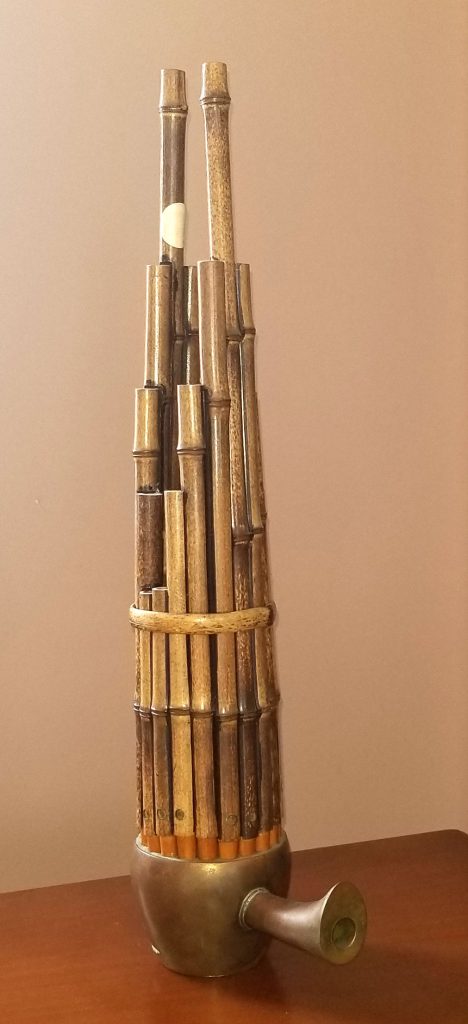
THE CHENG
Man has always sought to imitate the human voice with musical instruments. One of the most likely ways to get there was to go with the free or swing reed.
The free reed as a sound source was already used in antiquity.
The Chinese used it for the Cheng more than 2,000 years ago.
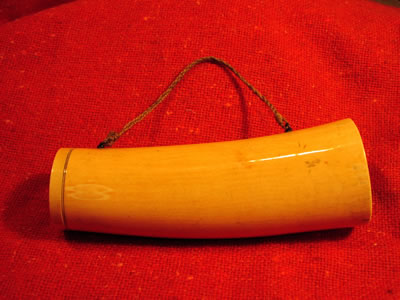 The EOLIAN
The EOLIAN
Shortly before the invention of the accordion there were many experiments conducted with the free reed. These bizarre instruments all had names derived from the Aeolian, such as the MundEolian, which means a mouth Aeolian.
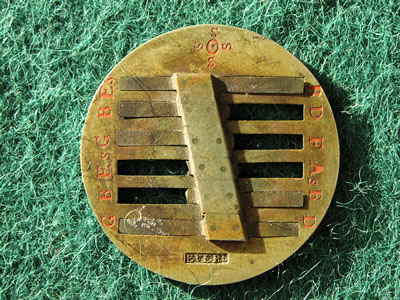
Seen above, the plate with its reeds which was housed inside the hunting aeolian (top left)
Following these experiments with the free reed, Friedrich Buschmann invented the harmonica in 1821. He then called it Aura.

In addition to wanting to imitate the human voice, man also sought to develop musical instruments capable of accompanying the human voice.
The musician playing the Buschmann harmonica, could not sing at the same time and we will see later how Cyril Demian, the inventor of the accordion, found the solution to this problem by adding bellows.

Above, we can see that the reedblock inside our accordions are real harmonicas.
Here is the Englishman Charles Wheatstone’s SYMPHONIUM in 1825.
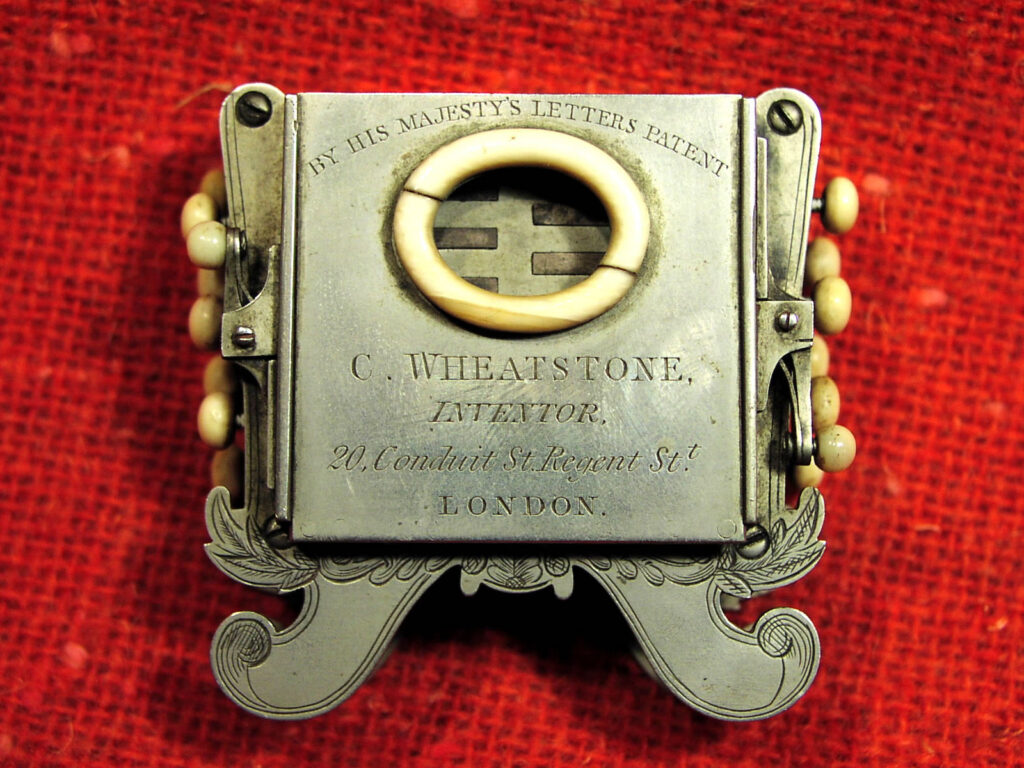
We can see here that the musician had to blow into the instrument just like the harmonica, to produce the wind necessary to activate the reeds which were inside the instrument. But Wheatstone had the ingenuity to add buttons on either side of the instrument. We will see later how he created the concertina by adapting a bellows to his symphonium.
Cyril Demian’s akkordion
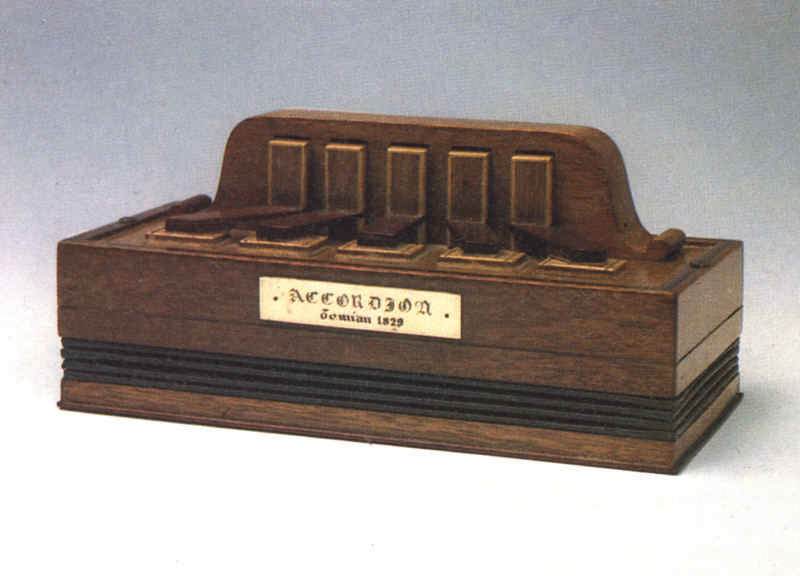
But it was the Austrian Cyril Demian who was the first to adapt a bellows to the harmonica.
In order to compete with Buschmann’s harmonica which could not be used as an accompaniment instrument, he made it so that each of the 5 keys gave two chords. A different chord depending on whether you push or pull the bellows.
This is what we call the DIATONIC system. From there on, all accordions will be diatonic until the adoption of the chromatic system around 1900. Although more developed than Demian’s accordion, diatonic accordions are still widely used today. They are found especially in traditional or folk music.
And now, guess where the accordion got its name from?
Because Cyril Demian’s first instrument produced only chords, he therefore quite simply named it Akkordion (with two “k” instead of two “c” as in French or English.)
It immediately had a big success since it could be used to accompany the singers, something the harmonica was unable to achieve.
Let me introduce you: the Accordion
It is quite right to say that instrumentalists do not “physically” know their instrument well; that they often know too little about its history, about its construction.
The accordionist is no exception to this rule. While the accordion remains, in the 20th century, one of the most played instruments in the world, one of the most popular, its followers are generally far from imagining the eventful adventures and the fascinating interest of its history. (more…)
Is there a French sound of the accordion?
- Published in accordion, accordion tuning, Bal musette, choosing your accordion, knowledge
The difference between the cabinets of chromatic accordions from the piano accordion’s cabinet.
We often hear about accordionists accustomed to playing on chromatic accordions who have a chromatic accordion made from a piano accordion body. What are the reasons that lead them to make this choice and what is the difference between the two options? This article tries to make the point. (more…)
- Published in accordion, Accordion Know How, choosing your accordion
The never-ending story…
En Italie… Once upon a time… dans une luxuriante vallée arrosée par le fleuve Musone, une ferme. Dans cette ferme, Antonio Soprani, sa femme et leurs fils, Paolo, Pasquale et Nicola. (more…)
- 1
- 2
